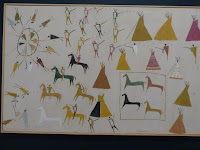Ottawa's National
Gallery of Canada (NGC) isn't the Smithsonian and it doesn't try to be.
It's mostly as advertised: a repository of works from our northern neighbor and
that makes it a treasure in its own right. Remarkably, prior to comedian Steve Martin's recent curation
of the works of landscape artist Lawren Harris, few Americans had thought much about Canadian art. Their loss. I
will highlight a few things that struck my fancy in a recent visit to the NGC.
Full disclosure: I'm not an art historian, so my remarks will be personal,
observational, and preferential.
The Canadian aesthetic begins with how Canadians view
indigenous peoples. They neither ghettoize native peoples nor assume that works
from academically trained practitioners of the "fine arts" tradition are
superior or more complex. It's normal to enter a NGC gallery and see works from
"First Nations Peoples" such as the Cree, the Crow, the Tlingit, or
the Métis (Indian/European mixed race) standing cheek by jowl with oils,
sculptures, and other pieces produced by Euro-Canadians. And when curators
comment on a Haida carved box from the Northwest, they do so with the same
reverent terms they apply to Impressionist or Renaissance paintings.
My favorite First Nations artists are the Inuit. Art from the
Arctic Circle region consists largely of ritual objects, stone-engraved prints,
graphic designs, drawings, sculpture, and vernacular items such as baskets,
clothing, fishhooks, harpoons, blankets, and tools. Some of these are ancient
and date as far back as the 5 th century BCE, but much is more
recent. That's because a lot Inuit art is analogous to that from Native
Americans of the Southwest: it developed in response to Euro-Caucasian market
forces. In other words, it was made for trade or sale. This became even more
pronounced in the 1960s when the Canadian government set up art cooperatives to
bring outside income into remote areas. It worked especially well in Cape Dorset,
located on the southwest tip of Baffin Island. Today, Cape Dorset prints and
carvings fetch handsome prices across the globe.
My love of
Inuit art comes from having seen works on paper from Pudlo Pudlat (1916-92) in both Montreal and Toronto in the 1970s,
and then the NGC's retrospective of his work in 1990. I'll leave it others to
determine Pudlo's place in the Inuit artistic pantheon, but if you have any
doubts about whether art can change society, consider that in the 1970s most
North Americans knew little about Baffin Island other than what they read in
tales of ice-bound explorers and now it's the center of Canada's newest
territory, Nunavut. Its art is
often naturalistic, mythical, or religious in nature, but there are also heavy
doses of geometric design and representations of ordinary life. Some of my
favorites are trenchant comments cloaked in humor on the ways in which
tradition melds, contrasts, and clashes with Western religion, politics,
customs and technology. There are scores of graphic artists on display at the
NGC, but you need not take a crash course to appreciate their skillfulness,
whimsy, or command of color and shape.
Carving is the best-known Inuit tradition. There's a gallery
devoted to centuries of Inuit carving and even a brisk walk through will reveal
the differences between museum and gallery quality works and the cheap
knockoffs pedaled in tourist shops. Carvers originally worked in antler and
ivory (from walruses and narwhals). Some still do as First Nations are allowed
to hunt whales and game, but most newer works are fashioned from resin, bone,
or soapstone—polished and buffed to a high sheen. These works are solid,
weighty, and tactile. Popular themes include marine animals, bears, mythical
creatures, and people.
 I highly recommend spending a lot of time in these
galleries. Let's face it, you don't need to go to Ottawa to see European art,
but you might to see stuff from Baffin Island. It may be the world's fifth
largest island (who knew?), but all of Nunavut has just 37,000 people. Inuit
art will help you imagine what life was once like in such a remote land. It
also challenges you to imagine it is now. Art and technology have helped
transform Nunavut, but next time you're in Montreal, pause to consider that
Cape Dorset is still another 1250 miles to the north!
I highly recommend spending a lot of time in these
galleries. Let's face it, you don't need to go to Ottawa to see European art,
but you might to see stuff from Baffin Island. It may be the world's fifth
largest island (who knew?), but all of Nunavut has just 37,000 people. Inuit
art will help you imagine what life was once like in such a remote land. It
also challenges you to imagine it is now. Art and technology have helped
transform Nunavut, but next time you're in Montreal, pause to consider that
Cape Dorset is still another 1250 miles to the north! 















